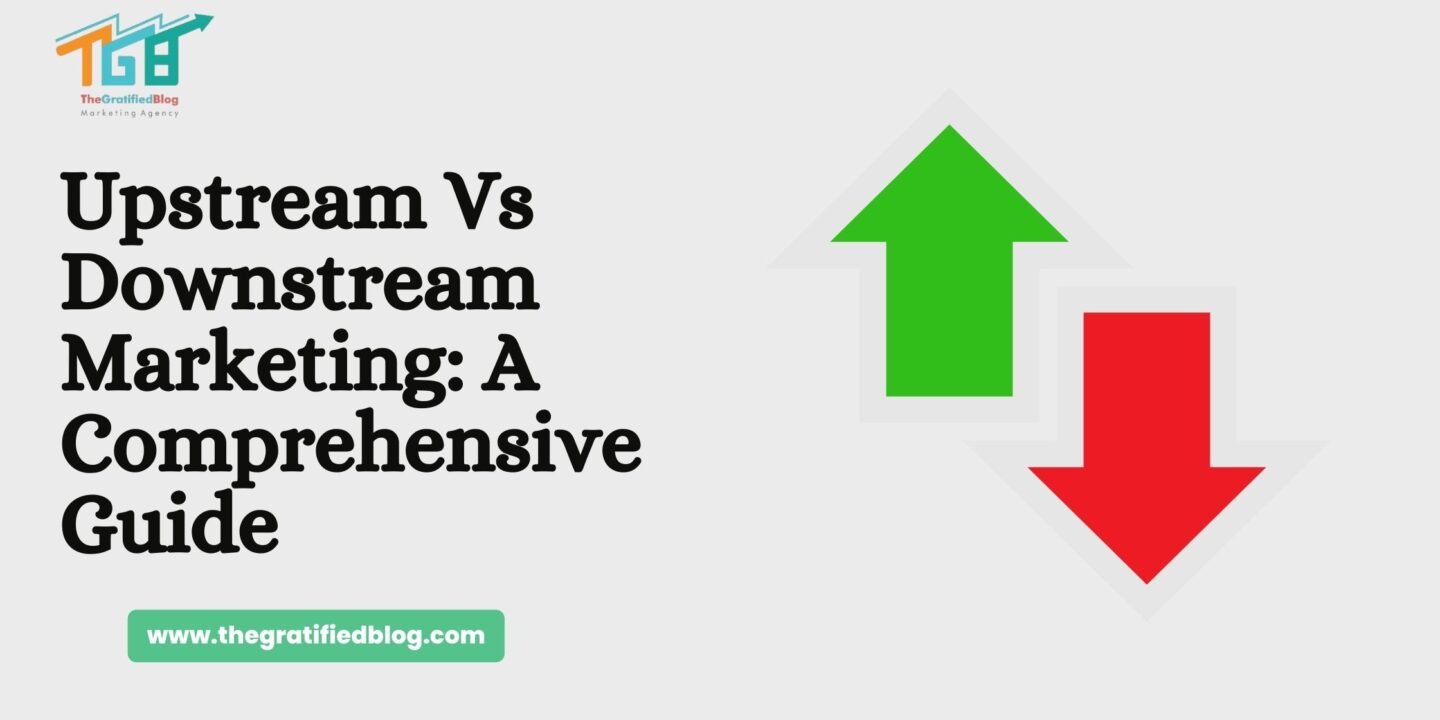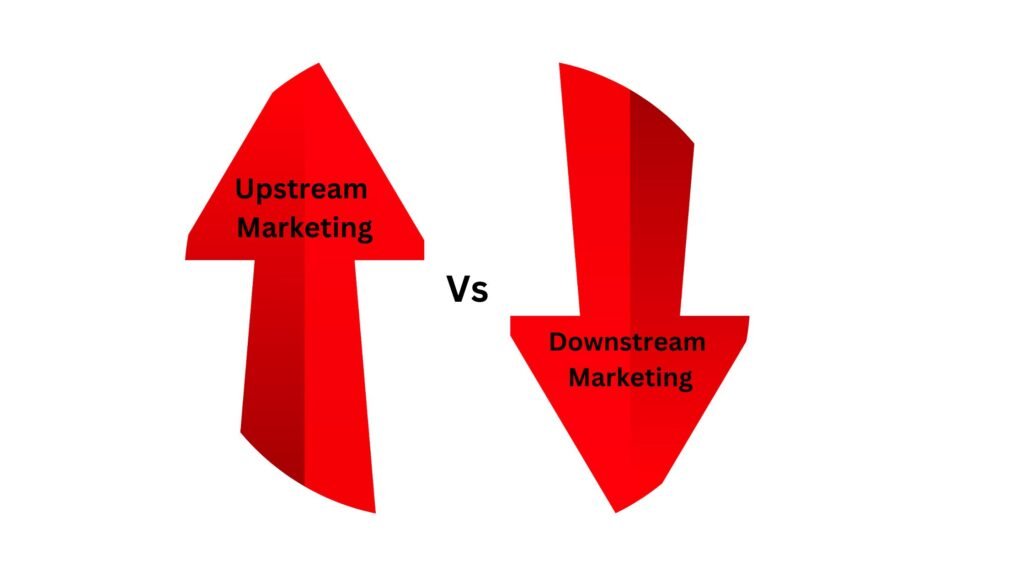
Greetings! We embark on our newest venture into the ever-changing realm of exploration realms of marketing strategy! This blog post delves into the intriguing dichotomy of “upstream vs downstream marketing.” In the fast-flowing river of business and consumer engagement, understanding the nuances between these approaches is akin to navigating the currents of success.
Join us as we embark on a comprehensive guide, unraveling the distinctions, advantages, and applications of upstream and downstream marketing strategies. Whether you’re a seasoned marketer or just dipping your toes into the waters of marketing theory, Let this guide serve as your navigational tool in navigating the (restatement) diverse landscapes of these pivotal marketing methodologies.
Let’s dive in!
What Is Upstream Marketing?
Upstream marketing refers to the strategic planning and activities early in the product development process, focusing on creating a solid foundation for successful market entry. It involves understanding customer needs, market trends, and competition to inform product development and marketing strategies.
In the illustrative flow of a river, upstream marketing is akin to going to the source, identifying market demands, and designing products or services that align with those demands. This approach emphasizes market research, product innovation, and establishing a solid brand image before introducing the product.
Critical Aspects Of Upstream Marketing
- Market Research: In-depth analysis of customer needs, preferences, and market trends to identify opportunities and gaps.
- Product Development: Creating products or services based on insights gained from market research and ensuring they meet the identified needs
- Brand Building: Establish a compelling brand image and Craft a value proposition that resonates with the intended audience.
- Target Audience Identification: Clearly define the target market and tailor products and messaging accordingly.
- Long-Term Strategy: Develop a comprehensive, long-term marketing strategy aligning with the business objectives.
What Is Downstream Marketing?
Downstream marketing refers to the activities and strategies after a product or service has been developed and is ready for market distribution. It involves promoting, selling, and delivering products to end consumers, focusing on driving sales and maximizing customer satisfaction.
In the illustrative flow of a river, downstream marketing is akin to navigating the current after the product has been developed. It encompasses various marketing mix elements, including promotion, distribution, sales, and customer support.
Critical Aspects Of Downstream Marketing
- Promotion and Advertising: Creating campaigns to raise awareness and generate interest in the product among the target audience
- Sales Channels: Identifying and optimizing the channels through which the product will be sold, whether through retailers, online platforms, or direct sales
- Distribution: ensuring efficient and effective product distribution to reach the intended customers.
- Sales Optimization: Implementing sales strategies to maximize conversion rates and revenue
- Customer Support: Providing post-purchase support and services to enhance customer satisfaction and loyalty
- Feedback Evaluation: Gathering and scrutinizing input from clients to inform future product improvements and marketing strategies
Upstream Vs. Downstream Marketing: Key Differences

“Upstream vs downstream marketing” represents two distinct phases in the product development and marketing process, each with its unique focus and objectives. Here are the critical differences between upstream and downstream marketing:
1. Focus:
- Upstream marketing focuses on strategic activities before the product is developed. It involves market research, product ideation, and brand building to lay the foundation for successful market entry.
- Downstream marketing centers around tactical activities after the product is ready for market distribution. It involves promotion, distribution, and customer support to drive sales and maximize customer satisfaction.
2. Timing:
- Upstream marketing occurs early in product development, setting the direction for product creation and market entry.
- Downstream Marketing: This takes place after the product is developed, concentrating on bringing the product to market, driving sales, and enhancing customer experiences.
3. Activities:
- Upstream marketing involves market research, product development, brand positioning, and long-term strategic planning.
- Downstream marketing encompasses promotion, advertising, sales optimization, distribution, customer support, and feedback analysis.
4. Goal:
- Upstream marketing aims to create a strong foundation for successful market entry by aligning products with market needs and establishing a compelling brand image.
- Downstream marketing aims to drive sales, maximize revenue, and build customer loyalty by effectively promoting and delivering the developed product to end consumers.
5. Customer Interaction:
- Upstream Marketing: Limited direct interaction with customers as the focus is on understanding market trends and designing products accordingly.
- Downstream marketing involves direct customer interaction through advertising, sales, and customer support to ensure satisfaction and gather feedback.
6. Long-Term vs Short-Term:
- Upstream marketing has a long-term focus, aiming to establish a strong foundation for sustained success.
- Downstream marketing often has a shorter-term focus, concentrating on immediate sales and customer satisfaction.
Upstream Marketing Examples
- Apple Inc.:
- Upstream Focus: Apple is known for its meticulous upstream marketing approach. Before introducing a new product, such as the iPhone or MacBook, Apple invests heavily in market research to understand consumer needs. The company innovates its products based on these insights, focusing on design, functionality, and user experience. The launch events, carefully orchestrated to build anticipation, exemplify the brand’s upstream strategy.
- Tesla:
- Product Innovation: Tesla’s upstream marketing strategy revolves around continuous innovation. Tesla creates products that align with evolving consumer preferences by investing in cutting-edge technology and sustainable energy solutions. The company’s upstream focus is on electric vehicles. Its standing as a frontrunner in (renewable energy) is attributed to the automotive and energy sectors.
- Procter & Gamble (P&G):
- Market Research and Brand Building: P&G, a consumer goods giant, emphasizes upstream marketing through extensive market research. The company identifies emerging trends and consumer needs to inform product development. Additionally, P&G strongly emphasizes brand building, creating a portfolio of trusted brands like Tide and Crest through upstream strategies.
Downstream Marketing Examples
- Coca-Cola:
- Promotion and advertising: Coca-Cola is a prime example of downstream marketing excellence. The company invests heavily in downstream activities such as advertising and promotion to maintain brand visibility and drive sales. The iconic Coca-Cola holiday commercials and promotional campaigns are classic examples of downstream marketing efforts to create consumer demand.
- Amazon:
- Sales Optimization and Distribution: Amazon’s downstream marketing prowess lies in its focus on sales optimization and distribution. The company employs sophisticated algorithms to recommend products based on customer behavior, optimizing the sales process. With its fast and reliable delivery, Amazon Prime exemplifies downstream strategies aimed at enhancing the customer experience and driving sales.
- McDonald’s:
- Customer Engagement and Feedback Analysis: McDonald’s excels in downstream marketing through customer engagement and feedback analysis. The company uses promotions, loyalty programs, and interactive advertising to engage customers. Additionally, McDonald’s actively collects and analyzes customer feedback through surveys and social media, allowing for continuous improvement based on downstream insights.
FAQs

Q1. What Distinguishes Upstream Marketing From Downstream Marketing?
A. Upstream focuses on product development and strategy, while downstream concentrates on customer engagement and sales.
Q2. How Do Upstream And Downstream Marketing Complement Each Other?
A. Upstream lays the groundwork for product success, and downstream ensures effective delivery to the target audience, creating a cohesive marketing strategy.
Conclusion
As we conclude this comprehensive guide to upstream vs downstream marketing, understanding and integrating both approaches becomes clear. Like skilled navigators, businesses can strategically plan their upstream journey, creating a solid foundation, and then smoothly transition downstream, riding the currents of effective promotion, sales, and customer engagement.
By appreciating the unique contributions of each approach, businesses can chart a course toward sustained success in today’s dynamic marketplace.








No Comments